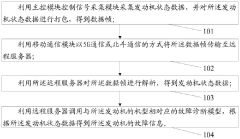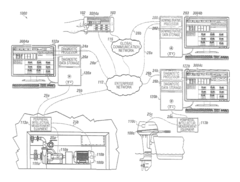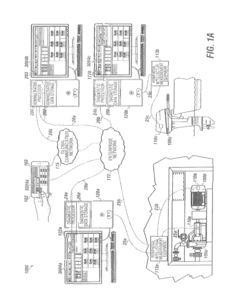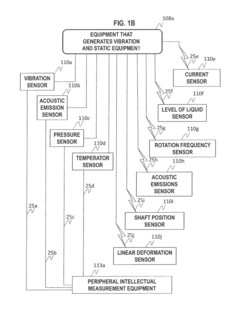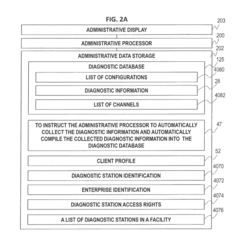The Use of 5G Technology in Real-Time V12 Engine Diagnostics
AUG 5, 20259 MIN READ
Generate Your Research Report Instantly with AI Agent
Patsnap Eureka helps you evaluate technical feasibility & market potential.
5G in V12 Diagnostics: Background and Objectives
The integration of 5G technology with V12 engine diagnostics represents a significant leap forward in automotive engineering and maintenance. This convergence of advanced telecommunications and high-performance engine technology aims to revolutionize the way we monitor, diagnose, and maintain complex V12 engines in real-time.
V12 engines, known for their power, smoothness, and prestige, have been a hallmark of luxury and high-performance vehicles for decades. However, their complexity has always presented challenges in terms of diagnostics and maintenance. Traditional diagnostic methods often require physical access to the engine and can be time-consuming, potentially leading to extended downtime for vehicles.
The advent of 5G technology offers an unprecedented opportunity to overcome these limitations. With its ultra-low latency, high bandwidth, and massive device connectivity, 5G enables the transmission of vast amounts of data in real-time. This capability is crucial for capturing and analyzing the myriad of parameters generated by a V12 engine during operation.
The primary objective of implementing 5G in V12 engine diagnostics is to establish a continuous, real-time monitoring system that can detect anomalies, predict potential failures, and optimize engine performance on the fly. This system aims to reduce maintenance costs, minimize vehicle downtime, and enhance overall engine reliability and longevity.
Furthermore, the integration of 5G technology in engine diagnostics aligns with the broader trend of connected and autonomous vehicles. As cars become increasingly sophisticated and data-driven, the ability to perform advanced diagnostics remotely and in real-time becomes not just beneficial but essential.
The development of this technology also addresses growing environmental concerns. By enabling more precise engine tuning and early detection of inefficiencies, 5G-enabled diagnostics can contribute to reduced emissions and improved fuel economy, even in high-performance V12 engines.
As we explore this technological synergy, it's important to consider the historical context. The evolution of engine diagnostics has progressed from simple mechanical checks to computerized on-board diagnostics (OBD) systems. The introduction of 5G represents the next significant step in this progression, promising a level of insight and control previously unattainable.
In conclusion, the use of 5G technology in real-time V12 engine diagnostics stands at the intersection of automotive excellence and cutting-edge telecommunications. It promises to redefine engine maintenance, enhance vehicle performance, and contribute to more sustainable high-performance motoring. The successful implementation of this technology could set new standards in the automotive industry and pave the way for similar applications across various sectors.
V12 engines, known for their power, smoothness, and prestige, have been a hallmark of luxury and high-performance vehicles for decades. However, their complexity has always presented challenges in terms of diagnostics and maintenance. Traditional diagnostic methods often require physical access to the engine and can be time-consuming, potentially leading to extended downtime for vehicles.
The advent of 5G technology offers an unprecedented opportunity to overcome these limitations. With its ultra-low latency, high bandwidth, and massive device connectivity, 5G enables the transmission of vast amounts of data in real-time. This capability is crucial for capturing and analyzing the myriad of parameters generated by a V12 engine during operation.
The primary objective of implementing 5G in V12 engine diagnostics is to establish a continuous, real-time monitoring system that can detect anomalies, predict potential failures, and optimize engine performance on the fly. This system aims to reduce maintenance costs, minimize vehicle downtime, and enhance overall engine reliability and longevity.
Furthermore, the integration of 5G technology in engine diagnostics aligns with the broader trend of connected and autonomous vehicles. As cars become increasingly sophisticated and data-driven, the ability to perform advanced diagnostics remotely and in real-time becomes not just beneficial but essential.
The development of this technology also addresses growing environmental concerns. By enabling more precise engine tuning and early detection of inefficiencies, 5G-enabled diagnostics can contribute to reduced emissions and improved fuel economy, even in high-performance V12 engines.
As we explore this technological synergy, it's important to consider the historical context. The evolution of engine diagnostics has progressed from simple mechanical checks to computerized on-board diagnostics (OBD) systems. The introduction of 5G represents the next significant step in this progression, promising a level of insight and control previously unattainable.
In conclusion, the use of 5G technology in real-time V12 engine diagnostics stands at the intersection of automotive excellence and cutting-edge telecommunications. It promises to redefine engine maintenance, enhance vehicle performance, and contribute to more sustainable high-performance motoring. The successful implementation of this technology could set new standards in the automotive industry and pave the way for similar applications across various sectors.
Market Demand Analysis for Real-Time Engine Diagnostics
The market demand for real-time V12 engine diagnostics using 5G technology is experiencing significant growth, driven by the automotive industry's push towards more efficient, reliable, and high-performance vehicles. This demand is particularly strong in the luxury and high-performance vehicle segments, where V12 engines are commonly used.
The integration of 5G technology in engine diagnostics offers several advantages that are highly valued by manufacturers and consumers alike. Real-time data transmission enables immediate detection of potential issues, allowing for proactive maintenance and reducing the risk of costly breakdowns. This capability is especially crucial for V12 engines, which are complex and expensive to repair.
In the luxury car market, where V12 engines are prevalent, there is a growing expectation for advanced technological features. Real-time diagnostics powered by 5G can provide drivers with instant feedback on engine performance, enhancing the overall driving experience and perceived value of the vehicle. This aligns with the trend of increasing connectivity and smart features in high-end automobiles.
The commercial vehicle sector, including high-end trucks and buses, also shows potential for adopting this technology. Fleet operators can benefit from real-time monitoring of engine performance, leading to optimized maintenance schedules and reduced downtime. This translates to significant cost savings and improved operational efficiency.
Racing and motorsports represent another key market segment for real-time V12 engine diagnostics. The ability to monitor engine performance in real-time during races can provide a competitive edge, allowing teams to make split-second decisions based on accurate, up-to-the-moment data.
The aftermarket and service sector is also poised to benefit from this technology. As 5G-enabled diagnostics become more prevalent, there will be an increased demand for compatible diagnostic tools and trained technicians. This creates new business opportunities for service providers and parts manufacturers.
From a geographical perspective, the demand is expected to be highest in regions with well-developed 5G infrastructure and a strong presence of luxury and high-performance vehicle manufacturers. This includes countries in North America, Western Europe, and parts of Asia, particularly Japan and South Korea.
As environmental regulations become stricter, there is a growing need for technologies that can help optimize engine performance and reduce emissions. Real-time diagnostics can play a crucial role in this area, helping manufacturers meet increasingly stringent environmental standards while maintaining high performance levels.
The integration of 5G technology in engine diagnostics offers several advantages that are highly valued by manufacturers and consumers alike. Real-time data transmission enables immediate detection of potential issues, allowing for proactive maintenance and reducing the risk of costly breakdowns. This capability is especially crucial for V12 engines, which are complex and expensive to repair.
In the luxury car market, where V12 engines are prevalent, there is a growing expectation for advanced technological features. Real-time diagnostics powered by 5G can provide drivers with instant feedback on engine performance, enhancing the overall driving experience and perceived value of the vehicle. This aligns with the trend of increasing connectivity and smart features in high-end automobiles.
The commercial vehicle sector, including high-end trucks and buses, also shows potential for adopting this technology. Fleet operators can benefit from real-time monitoring of engine performance, leading to optimized maintenance schedules and reduced downtime. This translates to significant cost savings and improved operational efficiency.
Racing and motorsports represent another key market segment for real-time V12 engine diagnostics. The ability to monitor engine performance in real-time during races can provide a competitive edge, allowing teams to make split-second decisions based on accurate, up-to-the-moment data.
The aftermarket and service sector is also poised to benefit from this technology. As 5G-enabled diagnostics become more prevalent, there will be an increased demand for compatible diagnostic tools and trained technicians. This creates new business opportunities for service providers and parts manufacturers.
From a geographical perspective, the demand is expected to be highest in regions with well-developed 5G infrastructure and a strong presence of luxury and high-performance vehicle manufacturers. This includes countries in North America, Western Europe, and parts of Asia, particularly Japan and South Korea.
As environmental regulations become stricter, there is a growing need for technologies that can help optimize engine performance and reduce emissions. Real-time diagnostics can play a crucial role in this area, helping manufacturers meet increasingly stringent environmental standards while maintaining high performance levels.
Current State and Challenges of 5G in Automotive Diagnostics
The integration of 5G technology in automotive diagnostics, particularly for real-time V12 engine monitoring, represents a significant advancement in the automotive industry. However, the current state of this technology implementation faces several challenges that need to be addressed for widespread adoption.
One of the primary obstacles is the limited 5G infrastructure, especially in rural or less developed areas. While major cities are rapidly deploying 5G networks, many regions still lack consistent coverage, hindering the reliability of real-time diagnostics for vehicles traveling across diverse geographical locations. This inconsistency in network availability poses a significant challenge for automotive manufacturers aiming to implement universal 5G-based diagnostic systems.
Another critical challenge lies in the complexity of integrating 5G technology with existing automotive systems. Many vehicles currently on the road are not equipped with 5G-compatible hardware, necessitating substantial retrofitting or limiting the technology to newer models. This integration process requires significant investment in research and development, as well as potential redesigns of vehicle architecture to accommodate new sensors and communication modules.
Data security and privacy concerns also present formidable challenges in the implementation of 5G-based diagnostics. The vast amount of real-time data transmitted from vehicles raises questions about data ownership, storage, and protection against cyber threats. Automotive manufacturers and service providers must develop robust security protocols to safeguard sensitive vehicle and user information, complying with increasingly stringent data protection regulations.
The high costs associated with 5G technology implementation pose another significant barrier. The expenses include not only the hardware and software required for in-vehicle systems but also the infrastructure needed to support high-speed, low-latency communications. These costs may be prohibitive for some automotive manufacturers, potentially creating a divide in the industry between those who can afford to implement the technology and those who cannot.
Standardization issues further complicate the adoption of 5G in automotive diagnostics. The lack of unified protocols and standards across different manufacturers and regions hampers interoperability and scalability. Efforts to establish industry-wide standards for 5G-based automotive systems are ongoing but face challenges due to competing interests and technological approaches.
Lastly, the automotive industry must address the technical challenges of ensuring real-time performance in V12 engine diagnostics using 5G. While 5G offers high-speed, low-latency communication, optimizing data processing and transmission to meet the stringent requirements of real-time engine monitoring remains a complex task. Engineers must develop sophisticated algorithms and data management systems to handle the massive influx of sensor data while maintaining the reliability and accuracy of diagnostic information.
One of the primary obstacles is the limited 5G infrastructure, especially in rural or less developed areas. While major cities are rapidly deploying 5G networks, many regions still lack consistent coverage, hindering the reliability of real-time diagnostics for vehicles traveling across diverse geographical locations. This inconsistency in network availability poses a significant challenge for automotive manufacturers aiming to implement universal 5G-based diagnostic systems.
Another critical challenge lies in the complexity of integrating 5G technology with existing automotive systems. Many vehicles currently on the road are not equipped with 5G-compatible hardware, necessitating substantial retrofitting or limiting the technology to newer models. This integration process requires significant investment in research and development, as well as potential redesigns of vehicle architecture to accommodate new sensors and communication modules.
Data security and privacy concerns also present formidable challenges in the implementation of 5G-based diagnostics. The vast amount of real-time data transmitted from vehicles raises questions about data ownership, storage, and protection against cyber threats. Automotive manufacturers and service providers must develop robust security protocols to safeguard sensitive vehicle and user information, complying with increasingly stringent data protection regulations.
The high costs associated with 5G technology implementation pose another significant barrier. The expenses include not only the hardware and software required for in-vehicle systems but also the infrastructure needed to support high-speed, low-latency communications. These costs may be prohibitive for some automotive manufacturers, potentially creating a divide in the industry between those who can afford to implement the technology and those who cannot.
Standardization issues further complicate the adoption of 5G in automotive diagnostics. The lack of unified protocols and standards across different manufacturers and regions hampers interoperability and scalability. Efforts to establish industry-wide standards for 5G-based automotive systems are ongoing but face challenges due to competing interests and technological approaches.
Lastly, the automotive industry must address the technical challenges of ensuring real-time performance in V12 engine diagnostics using 5G. While 5G offers high-speed, low-latency communication, optimizing data processing and transmission to meet the stringent requirements of real-time engine monitoring remains a complex task. Engineers must develop sophisticated algorithms and data management systems to handle the massive influx of sensor data while maintaining the reliability and accuracy of diagnostic information.
Existing 5G-Enabled V12 Engine Diagnostic Solutions
01 5G-enabled real-time health monitoring
5G technology enables continuous, real-time monitoring of patients' vital signs and health data. This allows for immediate detection of anomalies and rapid response to medical emergencies. The high-speed, low-latency nature of 5G networks facilitates the transmission of large volumes of health data from wearable devices and sensors to healthcare providers, enabling more accurate and timely diagnostics.- 5G-enabled real-time health monitoring: 5G technology enables continuous, real-time monitoring of patient health data through wearable devices and sensors. This allows for immediate detection of abnormalities and rapid response to potential health issues, improving patient care and outcomes.
- Remote diagnostics and telemedicine: 5G's high-speed, low-latency capabilities facilitate remote diagnostics and telemedicine services. Medical professionals can conduct virtual consultations, analyze medical images, and provide diagnoses in real-time, even from distant locations.
- AI-powered diagnostic systems: 5G networks enable the integration of artificial intelligence with diagnostic systems, allowing for rapid analysis of complex medical data. This combination enhances the accuracy and speed of diagnoses, potentially identifying diseases at earlier stages.
- Real-time data transmission for emergency services: 5G technology improves emergency response systems by enabling real-time transmission of vital patient data to hospitals and emergency services. This allows for better preparation and faster treatment upon arrival, potentially saving lives in critical situations.
- 5G-enabled medical IoT devices: The high bandwidth and low latency of 5G networks support a wide array of medical Internet of Things (IoT) devices. These devices can continuously collect and transmit patient data, enabling real-time monitoring and analysis for improved diagnostic accuracy and personalized treatment plans.
02 Remote diagnostics and telemedicine
5G technology enhances remote diagnostic capabilities by enabling high-quality video consultations and real-time data sharing between patients and healthcare professionals. This allows for more accurate remote diagnoses and reduces the need for in-person visits. The improved connectivity also supports the use of augmented reality and virtual reality in telemedicine, providing doctors with more detailed visual information for diagnostics.Expand Specific Solutions03 AI-powered diagnostic systems
5G networks support the integration of artificial intelligence and machine learning algorithms in diagnostic processes. These AI-powered systems can analyze vast amounts of medical data in real-time, assisting healthcare professionals in making more accurate and faster diagnoses. The high-speed data transmission of 5G enables these systems to access and process large datasets, including medical images and patient histories, for improved diagnostic accuracy.Expand Specific Solutions04 IoT integration for comprehensive diagnostics
5G technology facilitates the integration of Internet of Things (IoT) devices in healthcare settings. This allows for the collection and analysis of data from multiple sources, including wearables, environmental sensors, and medical equipment. The comprehensive data gathered through IoT devices provides a more holistic view of patient health, enabling more accurate and context-aware diagnostics.Expand Specific Solutions05 Edge computing for faster diagnostic processing
5G networks, combined with edge computing capabilities, enable faster processing of diagnostic data closer to the source. This reduces latency and allows for near-instantaneous analysis of medical information. Edge computing in 5G networks supports real-time processing of complex diagnostic algorithms, enabling quicker decision-making in critical medical situations and improving overall diagnostic efficiency.Expand Specific Solutions
Key Players in 5G Automotive Diagnostics
The integration of 5G technology in real-time V12 engine diagnostics is in its early development stage, with the market poised for significant growth. The technology's potential to revolutionize engine monitoring and maintenance is driving interest across automotive and telecommunications sectors. While the market size is currently modest, it is expected to expand rapidly as 5G networks become more widespread. Companies like Huawei, ZTE, and Qualcomm are at the forefront of 5G technology development, while automotive giants such as BMW are exploring its applications in engine diagnostics. The technology's maturity is progressing, with ongoing research and pilot projects, but widespread implementation is still in its nascent phases.
Huawei Technologies Co., Ltd.
Technical Solution: Huawei has developed a comprehensive 5G-based solution for real-time V12 engine diagnostics. Their system utilizes high-bandwidth, low-latency 5G networks to transmit large volumes of sensor data from V12 engines to cloud-based analytics platforms. The solution incorporates edge computing capabilities to process critical data locally, reducing latency for time-sensitive diagnostics. Huawei's 5G modules are designed to withstand harsh automotive environments, ensuring reliable connectivity even in challenging conditions. The company has also implemented advanced AI algorithms that can predict potential engine failures based on real-time data analysis, enabling proactive maintenance[1][3].
Strengths: Strong 5G infrastructure expertise, advanced AI capabilities, and robust hardware design. Weaknesses: Potential security concerns and reliance on global supply chains for key components.
BMW Brilliance Automotive Ltd.
Technical Solution: BMW Brilliance Automotive has developed a proprietary 5G-based diagnostics system for their V12 engines, focusing on integration with their existing vehicle architecture. Their solution utilizes a network of high-precision sensors throughout the engine, connected via 5G to a central diagnostics unit. The system employs machine learning algorithms that have been trained on extensive historical data from BMW's V12 engines, allowing for highly accurate predictive maintenance. BMW's platform also incorporates augmented reality features for technicians, enabling real-time visualization of diagnostic data overlaid on the physical engine. The company has implemented end-to-end encryption for all data transmission, ensuring the security and privacy of sensitive engine information[7][8].
Strengths: Deep integration with BMW's vehicle systems, extensive V12 engine expertise. Weaknesses: Solution may be limited to BMW vehicles, potentially less adaptable to other manufacturers.
Core Innovations in 5G-Powered Engine Diagnostics
Engine remote health monitoring system and monitoring method
PatentActiveCN112326255A
Innovation
- An engine remote health monitoring system is designed. It uses the signal acquisition module, main control module and remote server to establish a fault diagnosis model through neural network algorithms, collects engine status data in real time, and calls the corresponding fault diagnosis model of the model on the remote server. , to achieve unified monitoring and management of the engine, including the collection of temperature, pressure, acceleration and rotational speed sensors and the data transmission of 5G or Beidou communication.
System for automatic real-time diagnostics for equipment that generates vibration and static equipment
PatentActiveUS10132723B2
Innovation
- A system comprising sensors that transmit data to peripheral intellectual measurement equipment for processing, which is then compared to threshold values to generate diagnostic information, presented through multiple executive dashboards for real-time monitoring, analysis, and reporting, enabling automatic real-time diagnostics and maintenance scheduling.
5G Network Infrastructure for Automotive Applications
The implementation of 5G network infrastructure for automotive applications is a critical step in enabling real-time V12 engine diagnostics and other advanced vehicle functionalities. This infrastructure requires a comprehensive approach to ensure seamless connectivity, low latency, and high reliability for automotive systems.
The foundation of 5G network infrastructure for automotive applications lies in the deployment of small cells and macro cells. Small cells, including femtocells, picocells, and microcells, are crucial for providing dense coverage in urban areas and along major roadways. These low-power base stations enhance network capacity and improve signal quality, essential for maintaining consistent connectivity with moving vehicles.
Macro cells, on the other hand, offer wider coverage areas and are vital for ensuring connectivity in rural and less populated regions. The integration of both small and macro cells creates a heterogeneous network that can support the diverse needs of automotive applications across various environments.
To support the high data rates and low latency requirements of real-time V12 engine diagnostics, the 5G infrastructure must incorporate advanced technologies such as Massive MIMO (Multiple-Input Multiple-Output) and beamforming. Massive MIMO utilizes large arrays of antennas to significantly increase network capacity and spectral efficiency. Beamforming technology allows for focused transmission of signals, improving signal quality and reducing interference in densely populated areas.
Edge computing is another crucial component of the 5G infrastructure for automotive applications. By placing computing resources closer to the vehicles, edge computing reduces latency and enables real-time processing of critical data. This is particularly important for V12 engine diagnostics, where immediate analysis and response to engine performance data can prevent potential issues and optimize performance.
Network slicing is a key feature of 5G that allows for the creation of virtual, dedicated networks tailored to specific automotive applications. For V12 engine diagnostics, a dedicated network slice can be allocated to ensure prioritized data transmission and processing, guaranteeing the required quality of service even in high-traffic scenarios.
The implementation of 5G network infrastructure also necessitates the deployment of fiber-optic backhaul networks to connect base stations and data centers. This high-capacity backhaul is essential for handling the massive amounts of data generated by connected vehicles and ensuring low-latency communication between vehicles and cloud-based diagnostic systems.
To ensure seamless connectivity for moving vehicles, the 5G infrastructure must support advanced handover mechanisms. These mechanisms allow for smooth transitions between different cells and network slices, maintaining uninterrupted connectivity for real-time engine diagnostics and other critical automotive applications.
The foundation of 5G network infrastructure for automotive applications lies in the deployment of small cells and macro cells. Small cells, including femtocells, picocells, and microcells, are crucial for providing dense coverage in urban areas and along major roadways. These low-power base stations enhance network capacity and improve signal quality, essential for maintaining consistent connectivity with moving vehicles.
Macro cells, on the other hand, offer wider coverage areas and are vital for ensuring connectivity in rural and less populated regions. The integration of both small and macro cells creates a heterogeneous network that can support the diverse needs of automotive applications across various environments.
To support the high data rates and low latency requirements of real-time V12 engine diagnostics, the 5G infrastructure must incorporate advanced technologies such as Massive MIMO (Multiple-Input Multiple-Output) and beamforming. Massive MIMO utilizes large arrays of antennas to significantly increase network capacity and spectral efficiency. Beamforming technology allows for focused transmission of signals, improving signal quality and reducing interference in densely populated areas.
Edge computing is another crucial component of the 5G infrastructure for automotive applications. By placing computing resources closer to the vehicles, edge computing reduces latency and enables real-time processing of critical data. This is particularly important for V12 engine diagnostics, where immediate analysis and response to engine performance data can prevent potential issues and optimize performance.
Network slicing is a key feature of 5G that allows for the creation of virtual, dedicated networks tailored to specific automotive applications. For V12 engine diagnostics, a dedicated network slice can be allocated to ensure prioritized data transmission and processing, guaranteeing the required quality of service even in high-traffic scenarios.
The implementation of 5G network infrastructure also necessitates the deployment of fiber-optic backhaul networks to connect base stations and data centers. This high-capacity backhaul is essential for handling the massive amounts of data generated by connected vehicles and ensuring low-latency communication between vehicles and cloud-based diagnostic systems.
To ensure seamless connectivity for moving vehicles, the 5G infrastructure must support advanced handover mechanisms. These mechanisms allow for smooth transitions between different cells and network slices, maintaining uninterrupted connectivity for real-time engine diagnostics and other critical automotive applications.
Cybersecurity in 5G-Connected Vehicle Diagnostics
The integration of 5G technology in real-time V12 engine diagnostics has introduced new cybersecurity challenges that require robust protection measures. As vehicle systems become increasingly connected, the potential attack surface for malicious actors expands, necessitating a comprehensive approach to cybersecurity in 5G-connected vehicle diagnostics.
One of the primary concerns is the protection of sensitive diagnostic data transmitted over 5G networks. This includes real-time engine performance metrics, fault codes, and other critical information that could be intercepted or manipulated by unauthorized parties. To address this, advanced encryption protocols and secure communication channels are being implemented to ensure data integrity and confidentiality during transmission.
Authentication and access control mechanisms play a crucial role in safeguarding 5G-connected diagnostic systems. Multi-factor authentication, biometric verification, and role-based access control are being employed to prevent unauthorized access to vehicle diagnostic interfaces and data. These measures help ensure that only authorized personnel can interact with the diagnostic systems, reducing the risk of malicious interference.
The use of intrusion detection and prevention systems (IDPS) is becoming increasingly important in the context of 5G-connected vehicle diagnostics. These systems monitor network traffic and system behavior in real-time, identifying and responding to potential security threats. Machine learning algorithms are being leveraged to enhance the accuracy and efficiency of threat detection, enabling rapid response to emerging cybersecurity risks.
Over-the-air (OTA) updates present both opportunities and challenges for cybersecurity in 5G-connected vehicle diagnostics. While OTA updates allow for rapid deployment of security patches and system improvements, they also introduce potential vulnerabilities if not properly secured. Robust verification and validation processes are being implemented to ensure the integrity and authenticity of OTA updates before they are applied to vehicle systems.
As the automotive industry continues to embrace 5G technology for enhanced diagnostic capabilities, collaboration between automotive manufacturers, cybersecurity experts, and regulatory bodies is essential. This collaborative approach aims to develop and implement industry-wide standards and best practices for securing 5G-connected vehicle diagnostic systems, ensuring a consistent and comprehensive approach to cybersecurity across the automotive ecosystem.
One of the primary concerns is the protection of sensitive diagnostic data transmitted over 5G networks. This includes real-time engine performance metrics, fault codes, and other critical information that could be intercepted or manipulated by unauthorized parties. To address this, advanced encryption protocols and secure communication channels are being implemented to ensure data integrity and confidentiality during transmission.
Authentication and access control mechanisms play a crucial role in safeguarding 5G-connected diagnostic systems. Multi-factor authentication, biometric verification, and role-based access control are being employed to prevent unauthorized access to vehicle diagnostic interfaces and data. These measures help ensure that only authorized personnel can interact with the diagnostic systems, reducing the risk of malicious interference.
The use of intrusion detection and prevention systems (IDPS) is becoming increasingly important in the context of 5G-connected vehicle diagnostics. These systems monitor network traffic and system behavior in real-time, identifying and responding to potential security threats. Machine learning algorithms are being leveraged to enhance the accuracy and efficiency of threat detection, enabling rapid response to emerging cybersecurity risks.
Over-the-air (OTA) updates present both opportunities and challenges for cybersecurity in 5G-connected vehicle diagnostics. While OTA updates allow for rapid deployment of security patches and system improvements, they also introduce potential vulnerabilities if not properly secured. Robust verification and validation processes are being implemented to ensure the integrity and authenticity of OTA updates before they are applied to vehicle systems.
As the automotive industry continues to embrace 5G technology for enhanced diagnostic capabilities, collaboration between automotive manufacturers, cybersecurity experts, and regulatory bodies is essential. This collaborative approach aims to develop and implement industry-wide standards and best practices for securing 5G-connected vehicle diagnostic systems, ensuring a consistent and comprehensive approach to cybersecurity across the automotive ecosystem.
Unlock deeper insights with Patsnap Eureka Quick Research — get a full tech report to explore trends and direct your research. Try now!
Generate Your Research Report Instantly with AI Agent
Supercharge your innovation with Patsnap Eureka AI Agent Platform!


